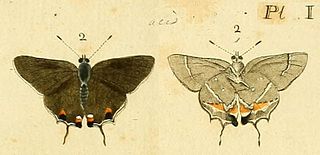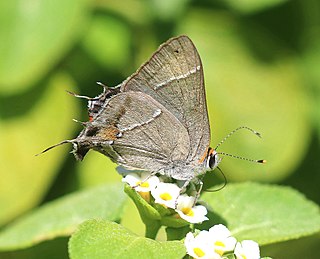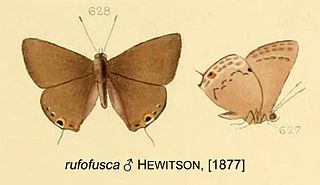
Lycaenidae is the second-largest family of butterflies, with over 6,000 species worldwide, whose members are also called gossamer-winged butterflies. They constitute about 30% of the known butterfly species.

The great purple hairstreak, also called the great blue hairstreak, is a common gossamer-winged butterfly species in parts of the United States. It is actually a Neotropical species; its North American range only includes the warm-temperate and subtropical parts of that continent, and it ranges southwards almost to the Isthmus of Panama. The type specimen, however, was shipped to Europe from the Colony of Virginia, probably around the time of the United States Declaration of Independence.

The gray hairstreak is also called the bean lycaenid or cotton square borer. It is a member of the Lycaenidae family, known as the gossamer-winged butterflies and the second-largest family of butterflies. It is one of the most common hairstreaks in North America, ranging over nearly the entire continent. It also occurs throughout Central America and in northern South America.
The Avalon hairstreak is a species of butterfly in the family Lycaenidae.

Strymon is a genus of scrub hairstreak butterflies in the family Lycaenidae. It is a highly distinct lineage in the tribe Eumaeini, and was at one time even treated as a monotypic tribe Strymonini. The species of the genus are found in the Nearctic, the Palearctic and the Neotropical realms.

Strymon bazochii, the lantana scrub-hairstreak or smaller lantana butterfly, is a butterfly in the family Lycaenidae. It is found from Paraguay north through Central America, the West Indies and Mexico to southern Texas. It was introduced to Hawaii in 1902 to control Lantana species, in which it has proven unsuccessful.

Strymon albata, the white hairstreak, is a butterfly of the family Lycaenidae. It was described by Cajetan Felder and Rudolf Felder in 1865. It is found from southern Texas to Costa Rica, Colombia, Venezuela and Trinidad.

Strymon alea, the Alea hairstreak or Lacey's scrub-hairstreak, is a butterfly of the family Lycaenidae. It was described by Frederick DuCane Godman and Osbert Salvin in 1887. It is found from north-western Costa Rica through Mexico to central and southern Texas. The habitat consists of subtropical thorn scrub.

Strymon istapa the mallow hairstreak, mallow-scrub hairstreak, dotted hairstreak or Hewitson's hairstreak. This diurnal butterfly is a widespread species that can be found in xeric habitats throughout the southern United States, Central America, parts of the Caribbean, and rarely in South America. This species can be spotted in rural and suburban areas in which human infringement has created open fields or tracks of overgrown weeds as a result of land clearing. These butterflies are often seen rubbing their hindwings together presumably to attract attention to their antenna mimicry scales located on the outer margin of the hindwing.

Strymon acis, the Bartram's scrub-hairstreak, is a butterfly of the family Lycaenidae. It is found in southern Florida and the West Indies. The habitat consists of openings in pine woods.

Strymon bebrycia, the red-lined scrub-hairstreak, is a species of hairstreak in the butterfly family Lycaenidae. It is found in North America.

Strymon martialis, known generally as martial scrub hairstreak, is a species of hairstreak in the butterfly family Lycaenidae. Other common names include the Cuban gray hairstreak and martial hairstreak.

Strymon rufofusca, known generally as the red-crescent scrub-hairstreak or red-crescent hairstreak, is a species of hairstreak in the butterfly family Lycaenidae.
Strymon yojoa, the yojoa scrub-hairstreak, is a species of hairstreak in the butterfly family Lycaenidae.













